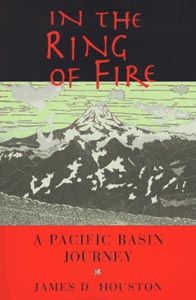Fellowship of the Ring
Santa Cruz author Jim Houston meets the people of the Pacific Basin
By Traci Hukill
EVER NOTICE THAT NO ONE tells jokes that start out "So this Pacific Rim guy walks into a bar ..."? That's because the world at large doesn't really know who the people of this region are. The Pacific Rim as a distinct geographical entity has inspired economists, travel agents, scholars, even chefs--but its wildly diverse population remains difficult to define.
What we need is a guide to usher us from Micronesia to Monterey Bay, from the Hawaiian Islands to Mt. Fuji, introducing us to friends and putting familiar faces on foreign cultures. Santa Cruz writer James D. Houston (whose newest novel, The Last Paradise, is due out in March) does just that in his book In the Ring of Fire: A Pacific Basin Journey, leading readers through his travels in Japan, Indonesia, Micronesia, Hawaii and California. Author and audience file into Japanese living rooms and karaoke lounges, Balinese temple-restaurants, a still-warm lava field on Hawaii, a steaming bath house at Tassajara.
Everywhere Houston goes he makes and records profound human contact. At a bath house in Japan, for example, he writes this of the twinkling little woman who shovels hot sand over his supine form: "And the look in the eyes of this woman is familiar too. You would recognize it anywhere. She is the tender-eyed lover, and the mother tucking you in at night, and the one who has come to bury you so that you can be born again."
Essentially a travel diary, In the Ring of Fire is the child of prose poetry and historical research. Its rhythm is a lilting, near-stream-of-consciousness stroll through observations, memories and philosophical musings. And though Houston is first a student of human nature, he includes dense, informative chunks of wartime history as well as discussions of architecture, geology and even botany in his chapters on Pacific Basin lands.
Even more memorable than Houston's impressive knowledge of his subjects are the snippets that bring home the reality of other places: desperate letters to Madame Pele accompanying volcanic rocks returned to Hawaii, a tipsy Japanese family crooning "Unforgettable" along with Natalie Cole, a BMW with a "Rugby Players Eat Their Dead" bumper sticker zipping along Highway 1. These details bring In the Ring of Fire to life and make it manageable, which is fortunate, because this book covers a lot of ground.
A little too much ground, perhaps. After a point, the places and people run together. Houston's technique succeeds in creating a general sense of what life is like in Japan, Bali and Saipan, but a reader looking for deeper mines of information will be frustrated. Houston's vignettes and impressions fly from the pages like birds: quick and beautiful, but elusive and fragile.
Then again, In the Ring of Fire didn't set out to be National Geographic. It's a far more delicate construct, a balance of poetry, contemplation and personal revelation delivered in a friendly voice. To read it is to spend an afternoon in the company of a surprisingly delightful stranger--it may not become a solid part of life, but it does add a graceful touch.
[ San Jose | Metroactive Central | Archives ]
Copyright © Metro Publishing Inc. Maintained by Boulevards New Media.
![]()

In the Ring of Fire: A Pacific Basin Journey
By James D. Houston
Mercury House; 224 pages; $14.95 paper
From the February 26-March 4, 1998 issue of Metro.
![[Metroactive Books]](/books/gifs/books468.gif)